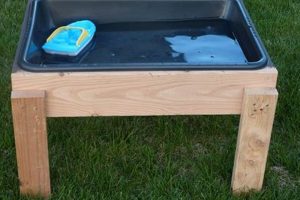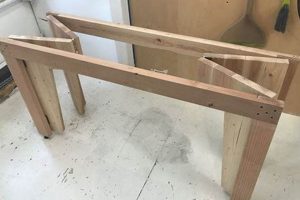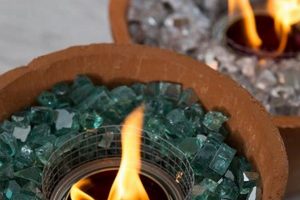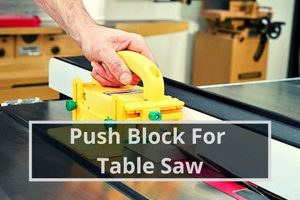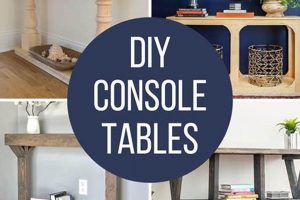A self-constructed surface designed to house a contained flame source, typically fueled by propane or natural gas, is frequently incorporated into outdoor living spaces for both aesthetic appeal and supplemental heat. These structures, often built from readily available materials such as concrete, stone, or metal, provide a focal point for gatherings. For instance, a homeowner might fabricate a rectangular concrete surround to accommodate a gas burner kit, effectively creating an outdoor gathering spot.
The integration of a contained flame feature into outdoor furniture offers several advantages, including extended seasonal usability of patios and decks. The addition of warmth allows for comfortable enjoyment of exterior spaces during cooler evenings. Historically, outdoor fire features have evolved from simple open pits to sophisticated, controlled systems, reflecting advancements in both safety and design. The contemporary trend towards personalized outdoor environments has fueled the increased interest in constructing customized flame-centered tables.
The following sections will explore design considerations, material selection, construction techniques, and safety protocols associated with creating a customized outdoor flame feature. Guidance on selecting appropriate burner kits, gas line connections, and regulatory compliance will also be provided.
Essential Construction Considerations
The creation of a customized outdoor flame feature requires meticulous planning and execution to ensure both functionality and safety. The following tips provide guidance for constructing a durable and aesthetically pleasing unit.
Tip 1: Material Selection: Concrete and stone are popular choices due to their inherent fire resistance and durability. However, ensure that any chosen material is rated for high-temperature exposure. Avoid combustible materials near the burner area.
Tip 2: Burner Kit Compatibility: Select a burner kit that is appropriately sized for the intended structure. Consider the British Thermal Unit (BTU) output, fuel source (propane or natural gas), and ignition system. Ensure the kit is certified by a recognized testing agency.
Tip 3: Ventilation is Paramount: Proper ventilation is crucial for propane-fueled models to prevent gas accumulation. Incorporate ventilation openings in the base structure to allow for adequate airflow.
Tip 4: Gas Line Connections: All gas line connections must be performed by a qualified professional. Ensure the gas line is properly sized to handle the BTU output of the burner. Leak testing is mandatory after any gas line work.
Tip 5: Drainage Provisions: Integrate drainage features into the design to prevent water accumulation within the structure, which can lead to damage and corrosion. Slope the interior surface to direct water towards drainage holes.
Tip 6: Structural Integrity: The support structure must be robust enough to withstand the weight of the materials and the burner kit. Consider the addition of reinforcing elements, such as steel rebar in concrete structures.
Tip 7: Surface Protection: Apply a sealant to the surface to protect it from staining and weathering. Choose a sealant specifically formulated for outdoor use and resistance to high temperatures.
Adhering to these construction considerations will result in a safe, functional, and visually appealing addition to outdoor living spaces. Prioritizing safety and durability is essential for long-term enjoyment.
The subsequent sections will delve into detailed construction techniques and aesthetic design options for creating a unique outdoor flame feature.
1. Safety protocols
The integration of safety protocols is paramount in the self-assembly of flame-featured tables. A failure to adhere to established safety standards can result in property damage, personal injury, or even fatality. The inherent risk associated with combustible fuels necessitates a comprehensive understanding and strict implementation of safety measures throughout the entire process, from initial design to final operation.
Consider the potential consequences of improper ventilation in a propane-fueled structure. Accumulation of propane gas can lead to an explosion, highlighting the cause-and-effect relationship between adequate ventilation and user safety. Similarly, the selection of non-fire-resistant materials near the flame source can result in ignition and rapid fire spread. Prioritizing certified burner kits, employing proper gas line connections performed by qualified professionals, and conducting thorough leak tests are critical components of responsible construction. Real-life examples of incidents involving improperly constructed outdoor flame features underscore the importance of diligent adherence to safety guidelines.
In conclusion, the safety protocols are not merely supplementary considerations, but rather integral elements of flame table construction. Strict adherence to established standards mitigates potential hazards, ensuring the safe and responsible use of flame features within outdoor living spaces. Neglecting these protocols undermines the entire project, transforming a potentially enjoyable amenity into a significant safety risk.
2. Material Durability
The longevity and safety of a self-constructed flame table hinge significantly on the durability of the selected materials. Outdoor exposure to weather elements and elevated temperatures from the flame source necessitates careful material selection to prevent premature degradation and potential hazards.
- Resistance to Thermal Stress
Materials used in direct proximity to the flame source must withstand high temperatures without warping, cracking, or combusting. Concrete, fire-rated brick, and specific types of stone are common choices due to their inherent thermal stability. For instance, using standard concrete blocks not rated for high heat exposure could lead to spalling and structural failure over time.
- Weather Resistance
The outdoor environment subjects the table to rain, snow, UV radiation, and temperature fluctuations. Materials must be resistant to water damage, fading, and freeze-thaw cycles. Untreated wood, for example, is highly susceptible to rot and decay, making it unsuitable for long-term use in exterior conditions without protective coatings and regular maintenance.
- Structural Integrity Under Load
The structure must support the weight of the materials themselves, the burner components, and any additional elements, such as decorative rocks or glass. Inferior materials could compromise the table’s stability, posing a safety risk. Reinforcing concrete with steel rebar, for instance, enhances its tensile strength and load-bearing capacity.
- Chemical Resistance
Exposure to cleaning agents, spilled fuel, and environmental pollutants can degrade certain materials. Selecting materials resistant to chemical attack ensures the table maintains its aesthetic appeal and structural integrity over time. For example, using a sealant designed for outdoor concrete surfaces helps protect against staining and erosion.
The interplay of these durability factors directly impacts the overall success and safety of the flame table. Prioritizing durable materials ensures a long-lasting, aesthetically pleasing, and safe outdoor feature. Neglecting material durability can lead to costly repairs, structural failure, and potential safety hazards, undermining the value and enjoyment of the self-constructed flame table.
3. Burner Compatibility
Burner compatibility represents a critical aspect in the successful construction of a self-assembled flame table. The selection of an appropriate burner kit directly impacts the functionality, safety, and aesthetic appeal of the final product. Mismatched components can lead to operational inefficiencies, potential hazards, and a compromised design.
- BTU Output and Table Size
The British Thermal Unit (BTU) rating of the burner must be proportional to the surface area of the table. An undersized burner will produce an anemic flame, while an oversized burner can generate excessive heat and pose a safety risk. For instance, a small, circular table might require a burner with a lower BTU output compared to a large, rectangular table designed for broader heat distribution. Proper sizing ensures a balanced aesthetic and safe operating temperature.
- Fuel Source Adaptation
Burner kits are typically designed for either propane or natural gas. Interchanging fuel sources without the appropriate modifications can result in inefficient combustion, carbon monoxide production, and potential explosions. A propane burner utilizes a different orifice size compared to a natural gas burner due to variations in pressure. Adapting a burner to an incompatible fuel source necessitates professional conversion and recalibration.
- Ignition System Integration
The burner’s ignition system must seamlessly integrate with the table’s design and fuel source. Ignition systems range from manual spark ignition to electronic ignition. Consider the ease of use and reliability of the ignition system in relation to the overall design. A complex electronic ignition system might require specialized maintenance and repair, while a simple spark ignition system offers greater reliability in remote locations.
- Safety Feature Compliance
Burner kits should comply with relevant safety standards and certifications, such as those issued by ANSI or CSA. Compliance ensures the burner has undergone rigorous testing for safe operation. Features like flame sensors and automatic shut-off valves mitigate the risk of gas leaks and explosions. Integrating certified components is crucial for responsible and safe construction.
The interplay between these compatibility factors dictates the ultimate success of a self-constructed flame table. Careful consideration of BTU output, fuel source adaptation, ignition system integration, and safety feature compliance is essential. Selecting a burner kit that aligns seamlessly with the table’s design and intended use guarantees a functional, aesthetically pleasing, and safe outdoor amenity.
4. Ventilation adequacy
Adequate ventilation represents a non-negotiable safety parameter in the construction and operation of any self-constructed flame-featured table, particularly those fueled by propane. Its importance stems from the inherent properties of combustible gases and the potential for hazardous conditions to arise from insufficient airflow.
- Preventing Gas Accumulation
Propane, heavier than air, tends to settle in enclosed spaces. Inadequate ventilation allows for the accumulation of propane within the table’s structure, creating an explosive atmosphere. This risk is particularly pronounced in designs incorporating enclosed bases or poorly ventilated burner compartments. Real-world incidents involving propane explosions in confined spaces highlight the potentially catastrophic consequences of insufficient ventilation. Correct ventilation design mitigates accumulation, diminishing the likelihood of ignition.
- Ensuring Complete Combustion
Proper combustion of propane requires a sufficient supply of oxygen. Insufficient ventilation restricts oxygen availability, leading to incomplete combustion and the production of carbon monoxide, a colorless and odorless toxic gas. Prolonged exposure to carbon monoxide can result in serious health problems or even death. Adequate ventilation ensures that the burner receives the necessary oxygen for complete combustion, minimizing carbon monoxide production.
- Facilitating Heat Dissipation
The burner generates significant heat during operation. Insufficient ventilation traps this heat, potentially damaging the structure of the table and creating a fire hazard. Excessive heat can also degrade components of the burner kit, shortening its lifespan and potentially compromising its safety features. Proper ventilation allows for the dissipation of heat, maintaining safe operating temperatures and preserving the integrity of the table and its components.
- Diluting Gas Leaks
Even with proper gas line connections and leak testing, minor gas leaks can occur over time. Inadequate ventilation allows for the concentration of these leaks, increasing the risk of ignition. Ventilation promotes the dilution of escaped gas, reducing the concentration to below the lower explosive limit (LEL), thereby diminishing the risk of ignition and subsequent explosion.
The interconnectedness of these factors underscores the paramount importance of ventilation adequacy. A design that prioritizes airflow minimizes the risks associated with gas accumulation, incomplete combustion, heat build-up, and gas leaks, thereby promoting the safe and responsible use of self-constructed flame tables. Neglecting ventilation compromises user safety, potentially transforming a desirable amenity into a serious hazard.
5. Gas regulation
The construction and operation of a self-assembled flame table are intrinsically linked to gas regulation. The safe and efficient function of such a device hinges on a comprehensive understanding and strict adherence to established regulations governing the storage, handling, and combustion of gaseous fuels, most commonly propane or natural gas. Failure to comply with these regulations can result in hazardous conditions, including gas leaks, explosions, and carbon monoxide poisoning. Gas regulation, therefore, constitutes a fundamental pillar in ensuring the safety and legality of any self-constructed flame table project. The regulations often dictate specific requirements for gas line connections, burner kit certifications, ventilation standards, and emergency shut-off mechanisms.
Specific examples illustrate the practical significance of gas regulation. Many jurisdictions require that any gas line connections be performed by a licensed and qualified professional. This requirement aims to ensure that connections are properly sealed and that the gas line is adequately sized to handle the BTU output of the burner. Similarly, regulations may mandate the use of burner kits certified by recognized testing agencies, such as ANSI or CSA. These certifications indicate that the burner has undergone rigorous testing to ensure its safe operation under various conditions. Furthermore, regulations often specify minimum ventilation requirements for propane-fueled tables to prevent the accumulation of explosive gas mixtures. Non-compliance may result in fines, project shutdown, or legal liability in the event of an accident. In essence, these regulations transform theoretical safety principles into concrete, actionable requirements.
Understanding the connection between gas regulation and the construction of self-assembled flame tables is critical for ensuring a safe and legally compliant project. While navigating the complex landscape of regulations can present challenges, prioritizing compliance mitigates potential hazards and legal liabilities. Adherence to gas regulation transforms a potentially risky endeavor into a responsible and enjoyable addition to outdoor living spaces. Further research into local building codes and consultation with qualified professionals are strongly advised to ensure comprehensive compliance and project success.
6. Aesthetic Design
The aesthetic design of a self-constructed flame table is a critical element that determines its integration with the surrounding outdoor environment and its overall visual appeal. It transforms a functional heat source into a focal point, contributing to the ambiance and character of the outdoor space. Thoughtful consideration of design principles elevates a simple fire feature into a cohesive and visually pleasing element.
- Material Harmony
The selection of materials significantly impacts the overall aesthetic. The chosen materials must complement the existing outdoor decor and architectural style. For instance, a contemporary patio might benefit from a flame table constructed with sleek concrete and stainless steel, while a rustic garden could be enhanced by a table made from natural stone and reclaimed wood. Incongruous material choices can detract from the aesthetic appeal and create a disjointed look. Harmonious material selection ensures a seamless integration with the surrounding environment.
- Form and Proportion
The shape and dimensions of the flame table must be proportionate to the size of the outdoor space and the surrounding furniture. An overly large table can overwhelm a small patio, while an undersized table might appear insignificant in a spacious garden. Similarly, the height of the table should be comfortable for seating and conversation. Careful consideration of form and proportion ensures visual balance and ergonomic functionality. The shape contributes to the overall design, offering the owner choice on angular to fluid design.
- Flame Presentation
The visible flame is a central element of the aesthetic. The burner kit and its placement influence the shape, size, and color of the flame. Some designs prioritize a wide, dispersed flame for ambient warmth, while others feature a concentrated, dramatic flame for visual impact. The addition of decorative elements, such as fire glass or lava rock, can further enhance the flame’s presentation and contribute to the overall aesthetic. The flame should be well-contained from high winds.
- Integration of Functionality
Aesthetically pleasing designs often seamlessly integrate functional elements. For example, a flame table might incorporate hidden storage for propane tanks or integrated lighting to enhance the ambiance after dark. The control panel for the burner should be discreetly located and easy to operate. The interplay between functionality and aesthetics contributes to a user-friendly and visually appealing design. It improves the flow and usability of the table.
The successful integration of these aesthetic design facets results in a flame table that not only provides warmth and illumination but also enhances the overall visual appeal of the outdoor space. A thoughtfully designed flame table becomes a central gathering point, contributing to the enjoyment and value of the outdoor living area. Prioritizing aesthetic considerations transforms a functional element into a design statement.
Frequently Asked Questions About Self-Assembled Flame Tables
This section addresses common inquiries and clarifies crucial aspects related to the design, construction, and safe operation of do-it-yourself flame tables.
Question 1: Is a building permit required for the construction of a flame table?
Permitting requirements vary significantly based on local building codes and regulations. Factors influencing the necessity of a permit include the size and location of the structure, the fuel source (propane or natural gas), and the proximity to other structures. Contacting the local building department before commencing construction is strongly advised to ensure compliance.
Question 2: What are the essential safety precautions when working with gas lines?
All gas line connections must be performed by a qualified and licensed professional. Ensure the gas line is properly sized to handle the BTU output of the burner. Leak testing using a soap solution is mandatory after any gas line work. Always shut off the gas supply before performing any maintenance or repairs.
Question 3: What type of materials are suitable for constructing the table’s surface?
Materials with inherent fire resistance and durability are essential. Common choices include concrete, fire-rated brick, and specific types of stone. Avoid combustible materials near the burner area. Ensure that any chosen material is rated for high-temperature exposure to prevent spalling, cracking, or ignition.
Question 4: How is adequate ventilation ensured in a propane-fueled flame table?
Propane, being heavier than air, requires specific ventilation provisions. Incorporate ventilation openings in the base structure to allow for adequate airflow and prevent gas accumulation. The size and placement of these openings depend on the overall design and volume of the enclosure.
Question 5: What is the appropriate BTU output for a flame table burner?
The appropriate BTU output depends on the size of the table and the desired level of heat output. A larger table generally requires a higher BTU rating. Consult the burner kit manufacturer’s specifications and consider the intended use of the table when selecting the BTU output.
Question 6: What type of maintenance is required for a flame table?
Regular maintenance includes cleaning the burner and surrounding area to remove debris, inspecting gas line connections for leaks, and checking the ignition system for proper function. Sealing the surface of the table to protect it from weathering and staining is also recommended. Consult the burner kit manufacturer’s instructions for specific maintenance recommendations.
Prioritizing safety, adhering to regulations, and selecting appropriate materials are paramount for constructing a durable and enjoyable self-assembled flame table.
The following section will delve into advanced design techniques and troubleshooting tips for creating a truly customized outdoor flame feature.
Conclusion
The preceding exploration of self-constructed flame tables reveals the intricate interplay of design, material science, safety protocols, and regulatory compliance inherent in such projects. Key considerations encompass material durability under thermal stress and weathering, burner compatibility concerning BTU output and fuel source adaptation, ventilation adequacy for mitigating gas accumulation and ensuring complete combustion, adherence to gas regulation standards, and thoughtful aesthetic design integration with surrounding environments. Neglecting any of these facets compromises the overall safety, functionality, and longevity of the structure.
While the allure of a customized outdoor flame feature is undeniable, the responsible execution necessitates a thorough understanding of the underlying principles and a commitment to meticulous construction practices. Further research into local building codes, consultation with qualified professionals regarding gas line connections, and a steadfast dedication to safety remain paramount. The successful creation of a self-assembled flame table represents not only a testament to craftsmanship but also a commitment to responsible and informed design.


